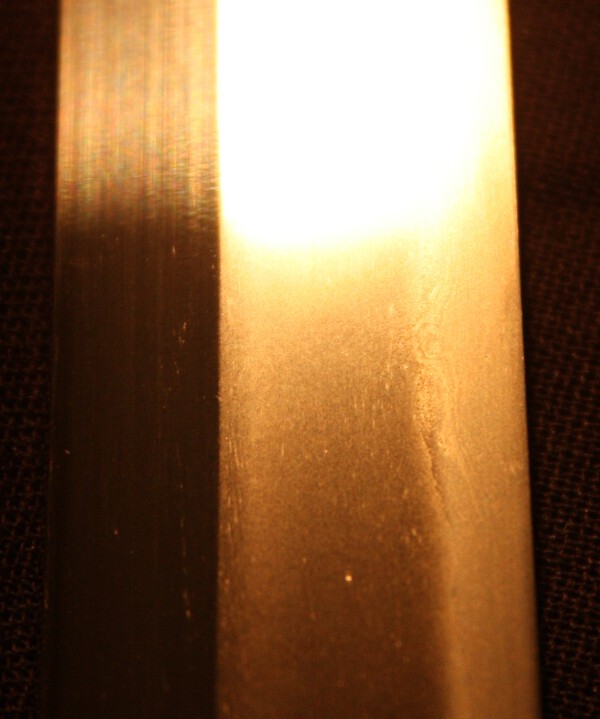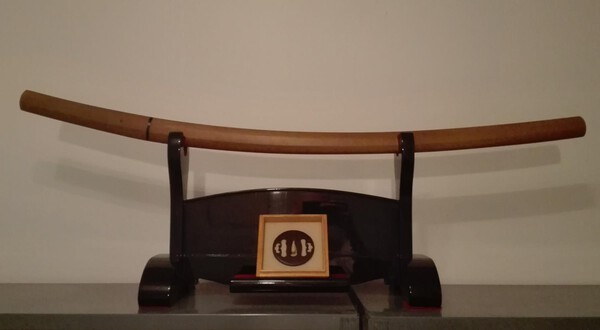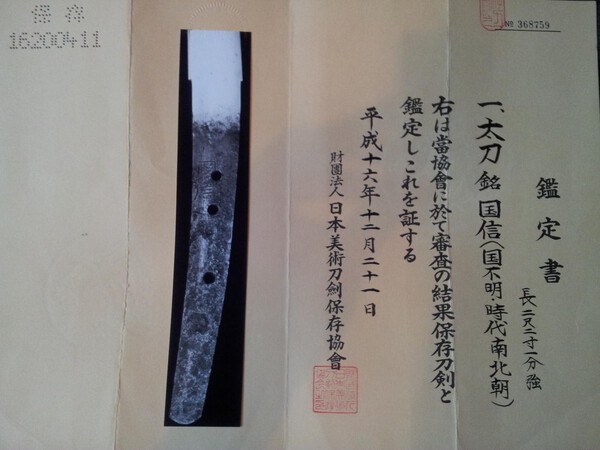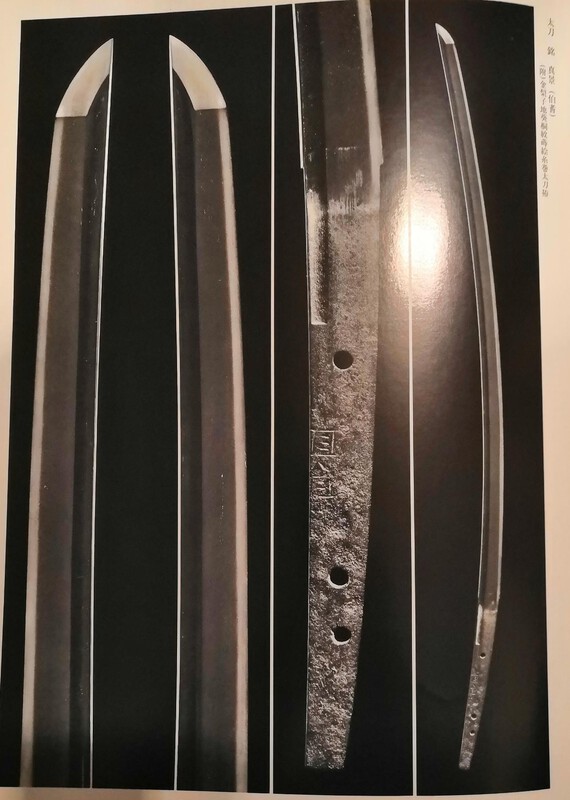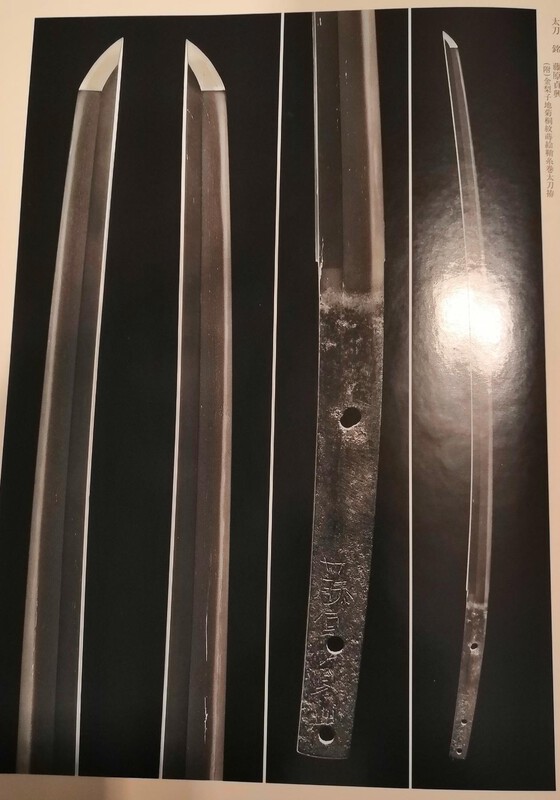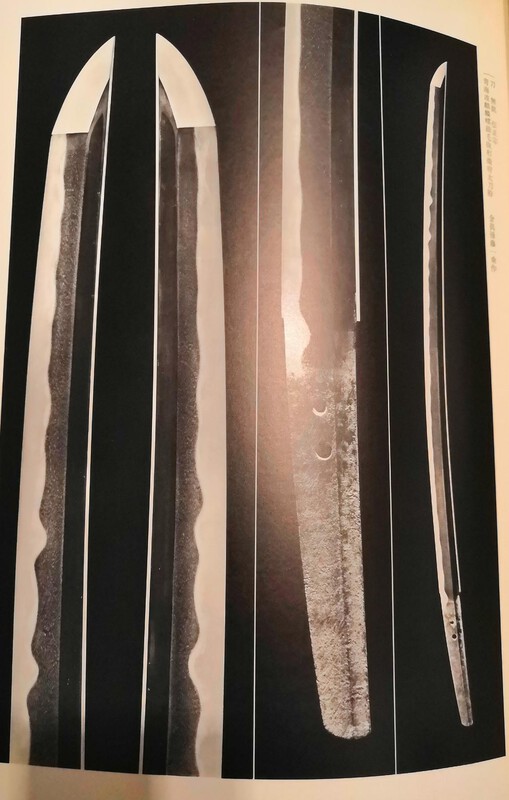-
Posts
2,169 -
Joined
-
Last visited
-
Days Won
37
Content Type
Profiles
Forums
Events
Store
Downloads
Gallery
Everything posted by Jussi Ekholm
-
It is interesting sword, caught my eye and interest. I think Michael gave a good info package there above. I'd give bit more leeway with the age. I'd see anything from Kamakura to early Muromachi as plausible options. And as I can not say anything about details in the blade I am just saying that there are few other Yoshitsugu smiths aside from Aoe. There is for example Muromachi Yoshitsugu from Sanjō, Bizen Yoshitsugu from Kamakura and Nanbokuchō, Yoshitsugu from Hokke during Nanbokuchō, those are some lesser known Yoshitsugu I have documented. Will be nice to see better pictures of the sword when you have it in hand. And if details of it point towards Aoe or something else. Hopefully you can get lot more measurements too, curvature, width, thickness etc. I am also throwing up a possibility of long early Muromachi katana out there. There are some strongly curved and long katana too, of course there can just be a false signature added on. Interesting sword to study.
-

Nanbokuchō Tachi signed Kuninobu NBTHK Hozon
Jussi Ekholm replied to Jussi Ekholm's topic in Sold Archive
On hold -
Well I have not really even thought about selling this sword as it is the best sword out of my 2 that I have. But Ray just happened to list a sword that got me hooked as I've been on a hunt for a wide sword, so I must think something in order to raise funds for it. So here will be a chance to get a signed Nanbokuchō period tachi in your collection. I have enjoyed this sword for many years and I am sure the potential future owner will too as this is quite nice and elegant sword with ver graceful sugata. Just to note if that sword that I am saving for gets sold I'll take this off from market. So this is a limited time offer. This sword has NBTHK Hozon which confirms the signature, 国信 Kuninobu, the paper has Kuni fumei / province unknown and places this to Nanbokuchō period. The Japanese dealer put this to early Nanbokuchō in their sales ad but personally I might put this to late Nanbokuchō. Jigane is tight itame hada and there is one section that has o-itame hada. Hamon is suguha based midare with good amount of activities. It is bit funny how the Japanese dealer stated "there is a little hada-are" while in reality there is quite nasty looking portion that I will show in picture. Other than this flaw I think the sword is in very good condition for as old as it is. The sword is probably a very slight machi-okuri but nearly in original shape. Fumbari can be seen at the base of the blade. The shape is very slender and graceful this is very light sword. Kissaki is quite tiny. Pictures will probably tell more than my words will. As this ad is done in bit of a haste after I got home from work I can't take any pics today as it is night now but I can take every type of picture potential buyer wants when I have time and daylight for it. So I'll use pics taken before. Sword has shirasaya and nice gold foil habaki. Nagasa: 67,2cm Sori: 2,0 cm Koshi-zori Motohaba: 3,05 cm Sakihaba: 1,65 cm Motoshinogikasane: 6,8 mm Motokasane: 5,6 mm Sakishinogikasane: 3,4 mm Sakikasane: 3 mm Nakago: 18,7 cm Nakagokasane: 8 mm Nakago sori: 0,4 cm Overall curvature: 3,6 cm Toshin weight: 574 grams You can ask all the questions you like and I'll answer them as well as I can. I strongly believe this will be the cheapest signed tachi from Nanbokuchō period that you'll encounter in a long time, that is actually in good condition as can be seen from the pictures. I've seen few (by less known smiths) in quite bad condition going for much more than my asking price. I've had this with me in several nihontō displays and meetings in Finland, and I brought this to Sweden for NBTHK Scandinavian meeting few years ago. Kinda sad to let this one go but in order to gather up some funds for making a change in my collection it is a must. Asking price: SOLD
-
That boshi makes the difference in attribution between schools?
-
Perhaps you could post a better picture of the signature? From the latest pics I am guessing 播磨大掾藤原 / 越前住 - Harima no Daijō Fujiwara / Echizen jū Granted really the only smith that the mei would fit is Shigetaka but it is missing the last 2 characters. As the picture does not show mei well it is very difficult to say anything but I think the signatures on both sides look different based on that one picture. As you are in Sweden I think you could also contact Scandinavian NBTHK branch for some help. I know they'd be happy to help you with all the questions you have. And of course we will help here at NMB as much as we can too.
-
Like the ad said it is signed 豊州高田住忠行 - Tadayuki lineage comes from Bungo province, they span roughly from 1700 to 1860. I just looked at the Bungo Taikan, and the mei on the sword for sale looks very different in style of the Tadayuki examples in the book. I don't think I have any examples of lesser known Tadayuki generations though. But I would be cautious with the signature.
-

Wanted: Tōken Bijutsu (Nbthk Magazine) Issues
Jussi Ekholm replied to Jussi Ekholm's topic in Wanted to Buy
Well I went with the Japan route, I've been buying way too much books and magazines from Japan... I thought I'd try my luck as I am just missing few years that are important for me. I've gotten more picky with my magazine search and I'd rather buy just full 12 issue year. I think I'll offer a generous 50€ per year + the postage. It's much more than they go for in Japan but I'm hoping to get some from Europe. Hoping to complete my current collecting goal for these magazines. Sure these years will eventually pop up for sale in Japan too but maybe I'll get them sooner this way and fellow NMB member gets some cash. 1991 - Issues 408 to 419 1986 - Issues 348 to 359 1985 - Issues 336 to 347 1984 - Issues 324 to 335 So 50€ per year for those 4 years. -

New Guy - New Swords - Introductions
Jussi Ekholm replied to ChrisM's topic in General Nihonto Related Discussion
Nuri-saya in general means lacquered saya. Usually the type of lacquer used is applied before the term. -

New Guy - New Swords - Introductions
Jussi Ekholm replied to ChrisM's topic in General Nihonto Related Discussion
By looking at the sayagaki quickly I think it has Bunroku/Keicho as the approximate age. You've chosen well with Markus as he can easily provide the full & correct translation to you -
I think Fred means this set: http://www.legacyswords.com/namban-futokoro.html
-
For Bungo the appreciation is generally for Sadahide & Yukihira being the absolute top tier for Bungo. Tomoyuki the Takada school founder comes behind them. Unfortunately after Tomoyuki there is a huge gap in traditional Japanese appreciation as Nanbokuchō / Muromachi gap is considered being so large. I think Taira Nagamori is one of the few Taira-Takada smiths that fills a bit of the Japanese appreciation criters. I do have the Bungo Taikan book and it features few other bit more famous Taira-Takada smiths but they are generally not too highly regarded. The book has a lineage of Taira-Takada smiths. You can also find shorter version of Takada lineage in Seskos book that has lineages of schools. I believe NBTHK has various types of attributions they can give to mumei Takada. I'd consider highest being attribution to Takada Tomoyuki, which would point the sword towards Nanbokuchō and skilled maker. I have documented few other NBTHK attributions to mumei Nanbokuchō more unknown Takada smiths but they are really rare. As my personal intrest starts to fade after early part of Muromachi I haven't documented the Muromachi Takada swords too closely. I know there are at least attributions (Takada), (Taira-Takada) and for Shintō there is (Fujiwara-Takada) for mumei blades.
-

Juyo Yamato Taima
Jussi Ekholm replied to Vermithrax16's topic in Auctions and Online Sales or Sellers
They are quite rare but so far I have documented 11 of them. I know there are more of them but I currently lack the data of them in form I want it. -
Did the Ko-Senjuin tachi have illegible signature (fumei)?
-

Japan Art expo 2020
Jussi Ekholm replied to paulb's topic in Sword Shows, Events, Community News and Legislation Issues
Had great time at the Expo last year and I'll be there next year too. I've said it on few occasions that I think broadening the scope a bit is a great idea and hopefully will bring in lots of interested folks. Got myself registered, any idea if 3-day pass like last year might be available for next year too? -

Swapping out good koshirae
Jussi Ekholm replied to Jussi Ekholm's topic in General Nihonto Related Discussion
I was doing nightly browsing of the Tokubetsu Jūyō books I have and there are some incredible swords passing some of which feature koshirae. Here are few interesting ones. Sorry about bad pics but it is the middle of night in here. Yep we have midnight sun in Finland during summer but still bit darkish at my apartment. I chose few that I found interesting. Long tachi from Heian almost 77cm, Hoki Sanekage and tachi koshirae Signed Hōshō tachi by Sadaoki and koshirae it has Meito tachi Mutsu Shintōgo Kunimitsu and koshirae Katana attribution den Masamune and I believe this papered together with the tachi koshirae it has It is rare occasion that sword papers together with the koshirae for Jūyō or Tokubetsu Jūyō but it happens sometimes. Of the above 4 I think the den Masamune sword is only one to pass with koshirae in paper while the koshirae are just mentioned for others in the entry. Latest to sword to pass Jūyō with koshirae seems to be mumei Rai Kunitoshi tanto in session 50. Sword & koshirae passing together was definately more common in early shinsa yet it was still rare even back then. The Yoshimune set Michael posted earlier is just incredible, it was on display at Samurai Art Expo, stunning. -

Which One of These Three
Jussi Ekholm replied to Prewar70's topic in Auctions and Online Sales or Sellers
I think it's a preference thing. For me the Sue-Sa on Nihontocraft wins hands down. I think it is great sword, too bad it's about 10 years too early for me to think of a sword at that level... Like you I've been checking that page probably few times every month. While other swords are nice too, I cannot compare them without bias as I like that Sue-Sa so much. Sa school swords often are wide in profile which I like a lot. This one is very attracting to me and I think it is better in quality than some Sa school swords that have passed Jūyō. Sue-Sa generally means broader attribution to late Nanbokuchō Sa school and they don't attribute to a specific smith. There are plenty of Sue-Sa blades that have passed Jūyō. -

Swapping out good koshirae
Jussi Ekholm replied to Jussi Ekholm's topic in General Nihonto Related Discussion
I think one thing that we might have skipped over is the historical value of item instead of artistic quality. Finding Kamakura - Nanbokuchō - Early Muromachi koshirae is incredibly rare and they have significant historical importance regardless of their quality. At least to me they easily top even the best much later koshirae just because of their age. When you visit Tokyo National Museum (or another Japanese museum with great display) and get to see some of the most treasured complete koshirae that remain to this day, I think that has certain prestige that you cannot take away just because koshirae might be plain etc. Then of course there are late Muromachi - Early Edo koshirae that have provenance to famous people, which should carry extra prestige too. There are also the rare occasions that a sword and koshirae have passed Jūyō together. They are very few in number. My own personal taste is toward very plain and utilitarian koshirae I really like plain old tachi koshirae compared against more elaborate ones, and same thing with katana koshirae. I dislike too fancy koshirae and would not really want to invest money on that. Of course I wouldn't break a ready set but high level of koshirae would most likely make it a pass for me. -
Well good thing about being with obsessive with tracking down swords is you'll often encounter lots of things that can leave you puzzled. At the end of May Meirin Sangyo got a Nobukuni wakizashi as a new addition to their inventory. I was positive I had seen that same sword quite recently and as I keep track of things, this was sold by Aoi Art. Now there is nothing funny about that as swords get passed between dealers a lot. However when this was sold by Aoi this had Hozon papered koshirae along with it and now little bit later it has different koshirae. There is nothing special in here as stuff like this probably happens a lot. I just thought I'd post this as it is important to keep your eyes open when shopping around. Here is a link to the current listing and Aois old listing http://www.nipponto.co.jp/swords5/WK328445.htm https://www.aoijapan.net/wakizashi-nobukuni-saemonjo/
-
Pictures would be needed, 綱家?
-
The Kuniyuki is signed tachi mei and if the signature is genuine it is a kodachi. I think the Kuniyuki is interesting piece, well worth further study. Kaneyoshi is Mino like Robert said earlier.
-
Here in Finland you can get "the good stuff" from pharmacy too. You have to ask the staff (as it is not publically available in here) and they'll ask the purpose for it, she was bit puzzled when I told it was for swords.
-

Jūyō & TJ pass rates
Jussi Ekholm replied to Jussi Ekholm's topic in General Nihonto Related Discussion
Here are the results for koshirae & tōsōgu. At first the submissions were grouped up but from 61 onwards there seems to be specific numbers sent in. For making things easier I will just use S for submissions then after the - numbers will be passes K will be koshirae and T will be tōsōgu. 42. 304 S - 21 K / 24 T 43. 247 S - 23 K / 31 T 44. 218 S - 22 K / 45 T 45. 198 S - 21 K / 49 T 46. 284 S - 28 K / 66 T 47. 368 S - 31 K / 64 T 48. 383 S - 25 K / 74 T 49. 414 S - 17 K / 71 T 50. 379 S - 13 K / 60 T 51. 344 S - 16 K / 65 T 52. 361 S - 13 K / 46 T 53. 367 S - 16 K / 63 T 54. 357 S - 11 K / 36 T 55. 309 S - 12 K / 38 T 56. 318 S - 9 K / 26 T 57. 244 S - 9 K / 18 T 58. 226 S - 12 K / 31 T 59. 236 S - 6 K / 19 T 60. ? S - 12 K / 39 T 61. 49 K / 277 T - 11 K / 37 T 62. 54 K / 274 T - 9 K / 29 T 63. 35 K / 284 T - 8 K / 36 T 64. 64 K / 300 T - 8 K / 25 T -
Well I am not a new sword guy but as I was going through Jūyō session 63, I noticed an interesting thing. It didn't occur to me at the moment but bit later as I was tackling more difficult Naotane mei and searched help for it. I found out that it is said that Naotane died 79 years old in 1857 5th month. In session 63 there was a Naotane sword that featured the following mei 荘司美濃介直胤作 八十翁 / 安政丁巳春吉日 which hints that he was 80 when he made it in 1857. Seems to me like he was born early in the year and was 80 when he died at least according to this sword. And this might have been among some of the last swords he made in his life. Unfortunately I do not own Zufu 63 so I thought I couldn't provide any info about that sword but as I googled I found out it is being sold by Aoi Art right now So here is that particular sword. https://www.aoijapan.com/katana80-okina-soshi-mino-suke-fujiwara-naotane-kao/
-

Jūyō & TJ pass rates
Jussi Ekholm replied to Jussi Ekholm's topic in General Nihonto Related Discussion
The Tokubetsu Jūyō shinsa is every two years and the 25th was in 2018 and 15th was in 1998. Give me few years and I should be able to come up with few sweet things if things go like I've planned. There is interesting stuff as Jūyō session 29 was the first one I've seen using the current format of submissions/passes. The older sessions have even more interesting layout of submissions. Unfortunately at the moment I am lacking the Tōken Bijutsu magazines pre-1979 so Jūyō 26 is the first session I have in magazines and pass rates for. The interesting thing in these old sessions is that they sort even the submissions for old swords / new swords. Jūyō 26 Kotō 366 submissions – 282 passes / Shintō 211 subs – 88 passes Jūyō 27 Kotō 491 submissions – 168 passes / Shintō 141 subs – 61 passes Jūyō 28 Kotō 245 submissions – 122 passes / Shintō 152 subs – 53 passes Unfortunately I do not have any easy way of telling the percentage on signed vs. mumei old swords that passed than counting by myself. Note that non-mumei include all forms of lacquer or gold signatures, faded signatures, etc. Session 63 - 119 old swords of which 82 are mumei swords Session 64 - 118 old swords of which 81 are mumei swords You can compare to the first 5 sessions for example Session 1 - 20 old swords of which 3 are mumei Session 2 - 28 old swords of which 10 are mumei Session 3 - 38 old swords of which 8 are mumei Session 4 - 40 old swords of which 14 are mumei Session 5 - 47 old swords of which 20 are mumei







